Myriam M L Grundy, Julien Labarre, Frederique Mayeur-Nickel, Jaap van Milgen, David Renaudeau
 In vitro models of digestion are useful
tools to explore the behavior of dietary fiber sources in gastrointestinal
conditions. To evaluate the validity of our digestion model, digesta obtained
in vivo and in vitro were characterized and the impact of cell wall integrity
on protein bioaccessibility and digestibility evaluated. Six
cannulated barrows [Pietrain × (Large White × Landrace)] were included in a 2 ×
2 Latin square design where they were fed two diets identical in chemical
composition but differing in nutrient bioaccessibility. Pea was given
either as flour (R1, most proteins encapsulated by intact cell walls) or
reconstituted flour (R2, mixture of proteins and purified, broken cell walls). Digesta
were collected at the duodenal and ileal cannulas at regular interval and after
slaughtering, following ingestion of either R1 or R2. The two diets were also
digested in vitro using a static gastrointestinal model. The original pea
ingredients as well as the digesta collected in vivo and in vitro were
characterized (i.e., particle size measurement, microscopy observations and gel
electrophoresis) and then compared with each other. The degradation of
the pea ingredients differed greatly between the two forms of flour, where
particles filled with nutrients were recovered at the latest stage of R1
intestinal digestion as observed with the particle size distribution and the
microscopy images. These results were consistent with the in vivo and in vitro
digestibility analysis that showed lower protein hydrolysis for R1 than that
for R2 (about 19% difference in protein digestion regardless of the method). Overall, great similarities were found between the digesta
collected in vivo and in vitro, especially regarding the particle size
measurements. To summarize, a substantial
proportion of the proteins contained in R1 was retained within the pea cells
following gastrointestinal digestion. These
encapsulated proteins reduced the amount of amino acids and small peptides
available for absorption. This mechanism will have
consequences on postprandial metabolism of amino acids and bacterial population
based on the delivery form of the dietary fiber.
In vitro models of digestion are useful
tools to explore the behavior of dietary fiber sources in gastrointestinal
conditions. To evaluate the validity of our digestion model, digesta obtained
in vivo and in vitro were characterized and the impact of cell wall integrity
on protein bioaccessibility and digestibility evaluated. Six
cannulated barrows [Pietrain × (Large White × Landrace)] were included in a 2 ×
2 Latin square design where they were fed two diets identical in chemical
composition but differing in nutrient bioaccessibility. Pea was given
either as flour (R1, most proteins encapsulated by intact cell walls) or
reconstituted flour (R2, mixture of proteins and purified, broken cell walls). Digesta
were collected at the duodenal and ileal cannulas at regular interval and after
slaughtering, following ingestion of either R1 or R2. The two diets were also
digested in vitro using a static gastrointestinal model. The original pea
ingredients as well as the digesta collected in vivo and in vitro were
characterized (i.e., particle size measurement, microscopy observations and gel
electrophoresis) and then compared with each other. The degradation of
the pea ingredients differed greatly between the two forms of flour, where
particles filled with nutrients were recovered at the latest stage of R1
intestinal digestion as observed with the particle size distribution and the
microscopy images. These results were consistent with the in vivo and in vitro
digestibility analysis that showed lower protein hydrolysis for R1 than that
for R2 (about 19% difference in protein digestion regardless of the method). Overall, great similarities were found between the digesta
collected in vivo and in vitro, especially regarding the particle size
measurements. To summarize, a substantial
proportion of the proteins contained in R1 was retained within the pea cells
following gastrointestinal digestion. These
encapsulated proteins reduced the amount of amino acids and small peptides
available for absorption. This mechanism will have
consequences on postprandial metabolism of amino acids and bacterial population
based on the delivery form of the dietary fiber.
2023, JAS, 101: skad037
https://doi.org/10.1093/jas/skad037
Registration hotline: 021-57634675
fax: 021-57632800
Copy right : 上海亘泰实业集团
Collaboration & Sponsorship: 021-57634938 57631012
ASASHotline:021-67868428
Site Map | CNZZStatistics
address:Shanghai songjiang jiuting town nine new highway 90 lane 3 nine new commercial building 15 floor

WeChat ID:asaschina
The pig nutrition international BBS CSIS